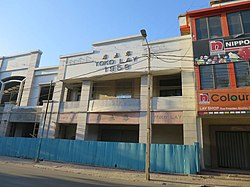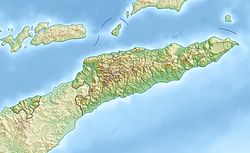Toko Lay
| Toko Lay | ||
|---|---|---|
 The Toko Lay - 黎 土庫 - main facade, 2015 |
||
| Data | ||
| place | Rua 25 de Abril, Colmera suco , Dili East Timor |
|
| Client | Lay family | |
| Construction year | 1959 | |
| Coordinates | 8 ° 33 '16.3 " S , 125 ° 34' 37.2" E | |
|
|
||
The Toko Lay ( Chinese 黎 土庫 / 黎 土库 , Pinyin Lí tǔkù , Jyutping Lai 4 tou 2 fu 3 - "Store Lay, department store Lay") is a building from the Portuguese colonial times in East Timor's capital Dili . The business and residential building of the Chinese-born Lay family - 黎 , Lí , Jyutping Lai 4 - with high ceilings was built in 1959 in the Colmera district and today houses a shop with building accessories. The Toko Lay is located on Rua 25 de Abril (formerly Rua Nicolau dos Reis Lobato , in colonial times Rua José Maria Marques ).
history
As a result of the unsafe situation caused by the civil war in East Timor in 1975 , many refugees gathered in the city's few large buildings in the second half of the year, including people from smaller towns such as Liquiçá , Suai and Same . The then owner Lay Tin Hsiong had already gone abroad. His brother-in-law, Chico Lay, gave the Chinese community permission to use the building. Among the refugees was Chong Kui Yan, a Chinese businessman from Dili and his family, who later told Amnesty International of the December 7, 1975 events. That day, Indonesia began the open invasion of East Timor and the attack on Dili . There were more than 100 people in the Toko Lay, all civilians. At 10 a.m., the Indonesians also started shooting at the house. Tsam Yi Tin, who is from Same, came from the annex to surrender and was shot. His son survived because he pretended to be dead after being hit. The Indonesians stormed the Toko Lay and sent all residents out. They were taken to the beach by the Sporting Clube de Timor clubhouse and had to sit in a row in the sand.
When the people cried out in fear, they were led 50 meters further to the harbor, where they were supposed to line up according to their size, facing the sea. The soldiers reloaded their rifles and pretended to shoot the prisoners. Then they were driven to the port gate and the rifles were reloaded again. Afterwards, women and children were sent to the Chinese school, the men had to dig graves for the victims of the invasion or throw the bodies into the sea. After doing the work, 20 Colmera Chinese were again placed facing the sea and then shot in the head. This was followed by other groups who were also killed. A total of 59 Chinese and Timorese were executed. The population was asked to keep count. The executions were justified by the Indonesians in retaliation for the death of an Indonesian paratrooper at the Toko Lay. The dead soldier is said to have hung on the Toko Lay. The victims were weighted with stones by prisoners and thrown into the water. Chong Kui Yan was one of the workers who had to dispose of the bodies and was allowed to leave afterwards. Among the named victims of the shootings are eleven people named Lay, between the ages of 16 and 60 years. At the monument to Henry the Navigator in front of the Government Palace was one in construction work from June to July 2012 mass grave discovered at least 72 bodies. It was unclear whether they were victims of the Indonesian invasion and the subsequent executions in the Toko Lay or who died in World War II . Since the dead were relatively large, it was assumed that the victims were members of the Chinese minority. An international team of experts from Australia , Malaysia , Korea and Thailand should investigate the case.
The Toko Lay was also damaged during the Indonesian Operation Donner in 1999. After the Indonesians left in the same year, Lay Chung Eng, the founder's son, continued to run the business.
See also
Individual evidence
- ↑ Term “tǔkù 土庫 / 土库 aka toko”. In: www.zdic.net. Retrieved on March 30, 2020 (Chinese, the term "tǔkù 土庫 / 土库 aka toko" means on the one hand "private treasure store" on the other hand a loan term from Chinese during the Ming period in the former colonial areas of the Netherlands and Great Britain - today Indonesia, Malaysia - for "commercial shop" or commercial establishment.).
- ^ Term "Lí 黎 aka Lay". In: www.zdic.net. Retrieved on March 30, 2020 (Chinese, German, English, French, the term "Lí 黎 aka Lay" is a family name here .).
- ^ Term "Lí 黎 aka Lay". In: Leo.org . Retrieved on March 30, 2020 (Chinese, German, the term "Lí 黎 aka Lay" is a family name here .).
- ↑ a b c d e Vaudine England: Chinese legacy of fear in Dili. In: www.etan.org from South China Morning Post . August 30, 1999, accessed March 19, 2018 .
- ↑ Flávio Miranda and Isabel Boavida: Dili's Architectural Heritage of Portuguese Origins. In: issuu.com. October 14, 2015, accessed March 18, 2018 .
- ↑ a b c Chapter 7.2 Unlawful Killings and Enforced Disappearances. ( PDF file; 2.5 MB) In: www.etan.org. Retrieved on March 19, 2018 (English, PDF from the “Chega!” Report of the CAVR ).
- ↑ James E. Waller: Becoming Evil: How Ordinary People Commit Genocide and Mass Killing . 2nd Edition. Oxford University Press, USA 2007, ISBN 978-0-19-977485-2 , pp. 129 , Part I - What are the Origins of Extraordinary Human Evil - The Invasion of Dilli (English, preview in Google Book Search).
- ↑ Jakarta Globo: Mysterious mass grave at East Timor PM's office , June 26, 2012 ( July 18, 2012 memento in the Internet Archive ), accessed June 27, 2012
- ↑ Channel News Asia: Bodies in Timor Leste mass grave likely Chinese: Police , July 13, 2012 , accessed July 14, 2012
- ^ Bodies in Timor Leste mass grave likely Chinese: Police. In: www.easttimorlawandjusticebulletin.com. July 14, 2012, accessed April 2, 2020 .
- ↑ Vaudine England: Catch a red taxi to downtown Dili. In: South China Morning Post . October 4, 2001, accessed March 19, 2018 .
